Dark Tourism destinations were once the remit of a select group of travellers. However, after the launch of popular Netflix show Dark Tourist, these attractions have hit the mainstream.
If you’re interested in the morbid and the macabre, look no further. After making several visits to dark history sites myself, I’ve teamed up with other travellers to bring you this list of dark tourism destinations all around the world.
Read more: (opens in new tab)
17 Must-Visit Dark Tourism Destinations
1. Chernobyl Exclusion Zone – Kyiv, Ukraine
The abandoned amusement park in Pripyat is one of dark tourism’s crowning images. The haunting stills of the fairground that never heard the laughs of children hang in modern consciousness, a symbol of tragic loss and a warning of the mistakes men can make.
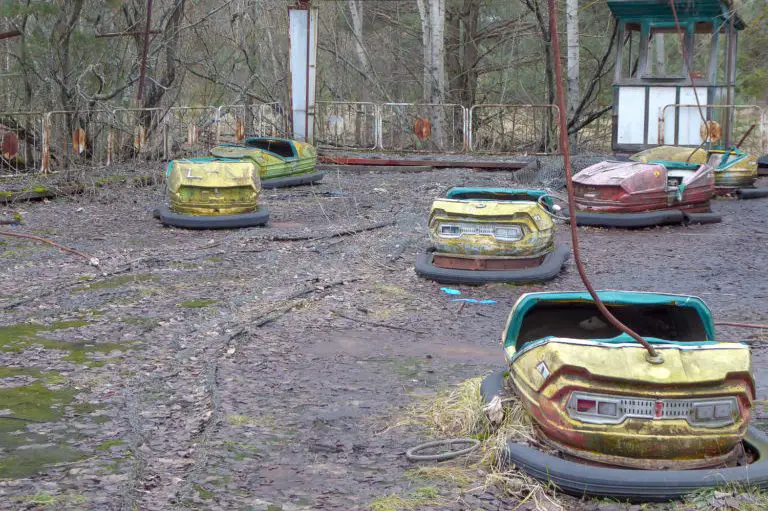
In 1986, the nuclear reactor at the Chernobyl power plant exploded, causing the worst nuclear accident in the world’s history. The effects were huge; people were forced to evacuate their homes and the surrounding areas became a hotbed of radiation. It was predicted that never again in our lifetime, would Chernobyl be inhabited by anything living.
Surprisingly, the Chernobyl exclusion zone has recovered quicker than was ever predicted. Although there are still risks with spending long periods in the exclusion zone, wild animals have returned and are thriving. Despite its recovery, Chernobyl acts as a very sobering reminder of the damage humanity can do without intention.
2. Sucre Cemetery – Sucre, Bolivia
Sucre Cemetery is an unlikely attraction in Bolivia’s capital. Regularly appearing on tourist maps, it is a peaceful place which attracts visitors who come to see how the Bolivians handle death and all that comes after.
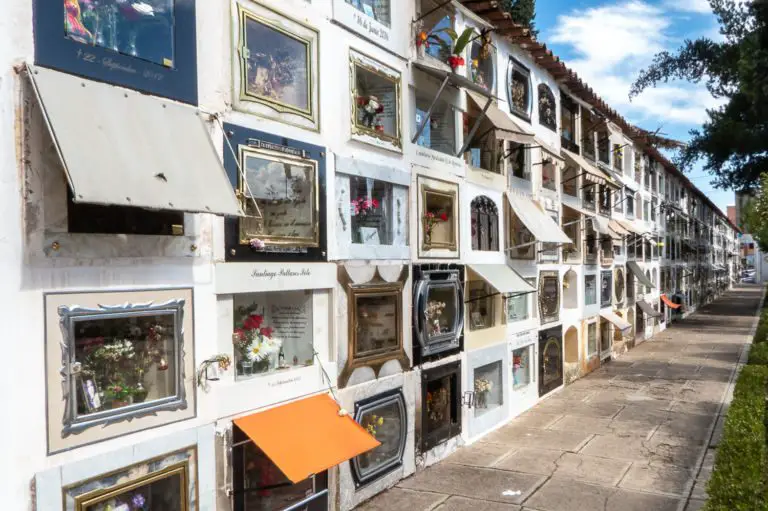
Also frequently visited by locals, this cemetery is a surprisingly popular spot for catching up with friends, studying and paying homage to the dearly departed.
Unlike other cemeteries I’d visited, these graves were arranged in a block system above ground. The vast majority of these were carefully maintained and were regularly stocked with gifts for departed loved ones. Small bottles of spirits were a common appearance, alongside slices of cake!
In Bolivia, death is accepted as an inevitability of life. While graveyards ultimately provide a space for burial, they hold a far more important symbolic role in Bolivian culture. Although death is traditionally seen as a dividing force, Sucre Cemetery demonstrates that death can continue to unite us all, long after somebody is gone.
3. The Poison Garden – Alnwick, England
Home to around 100 toxic and narcotic plants, the Poison Garden is undoubtedly one of the best things to do in Alnwick. This small but deadly garden is home to some of the world’s most dangerous plants and visitors are only allowed to enter on a guided tour.
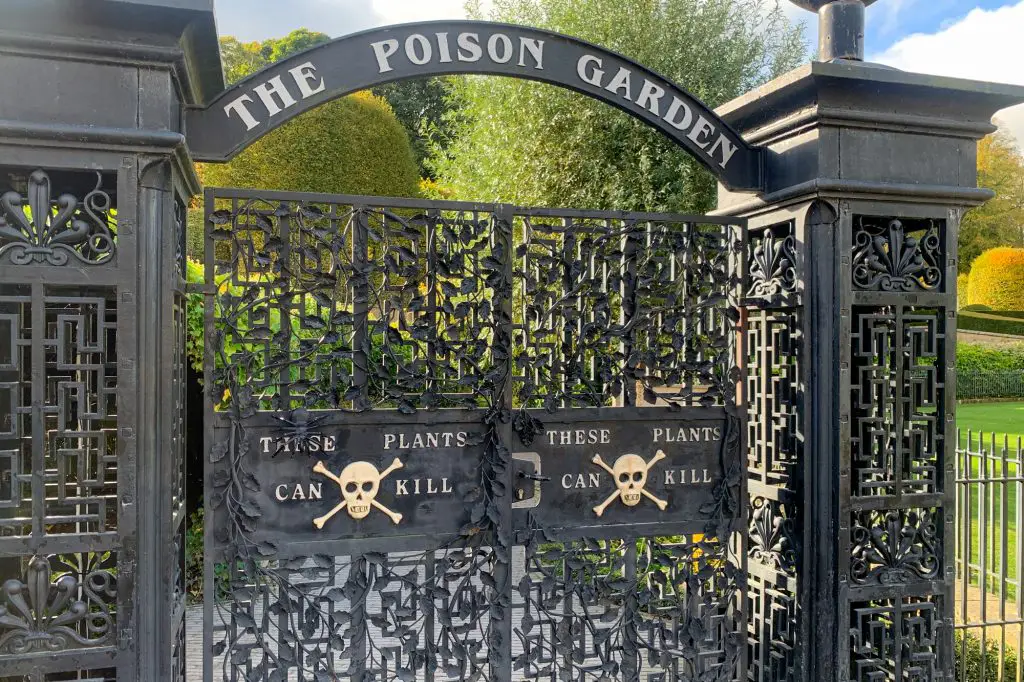
Deadly nightshade, cannabis and coca (the plant from which cocaine is derived) are a few examples of the plants housed in the Poison Garden. Visitors are prohibited from touching any of the greenery and there have even been cases of people passing out after smelling the plants!
The tour guides at the Poison Garden are great at explaining the real-life application of the plants using case studies such as Harold Shipman (Doctor Death) and Graham Young (The Teacup Poisoner). The garden also runs tours for local school children, educating them about drug use.
4. Paneriai Massacre Site – Vilnius, Lithuania
Paneriai is one of Vilnius’ many neighbourhoods. However, it will be forever remembered as the Ponary massacre site. The Einsatzgruppen (Nazi death squads) rounded up groups of Jews from the Vilna Ghetto, took them to Paneriai, executed them and forced other Jewish prisoners to dig mass graves and bury them.
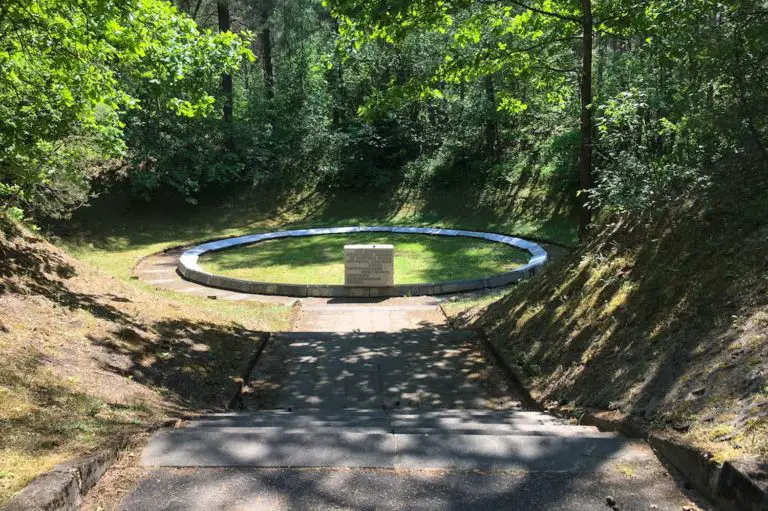
There are six burial sites within the complex, each the site of multiple mass executions. Because so many sets of bodies are stacked on each other, it is impossible to know the exact number of deaths. It is estimated to be around 100,000.
Those brought to Paneriai were burned to death in an attempt to destroy evidence. They were then shovelled into the pits, which today are marked by memorials. Like many of the massacre sites in the Baltics, Paneriai is a forested area. This makes walking around a surreal experience as it is quiet, peaceful and beautiful, a stark contrast to the memorials reminding you that thousands of people were slaughtered there.
Contributed by Cultura Obscura. Follow them on Facebook!
5. St. Nicholas’ Church – Hamburg, Germany
In July 1943, Hamburg was the target of an allied aerial World War Two bombing. The tall spire of St. Nicholas’ Church was used as an orientation marker and the building was almost completely destroyed. All that remained were some external walls, the crypt and most of the tower.
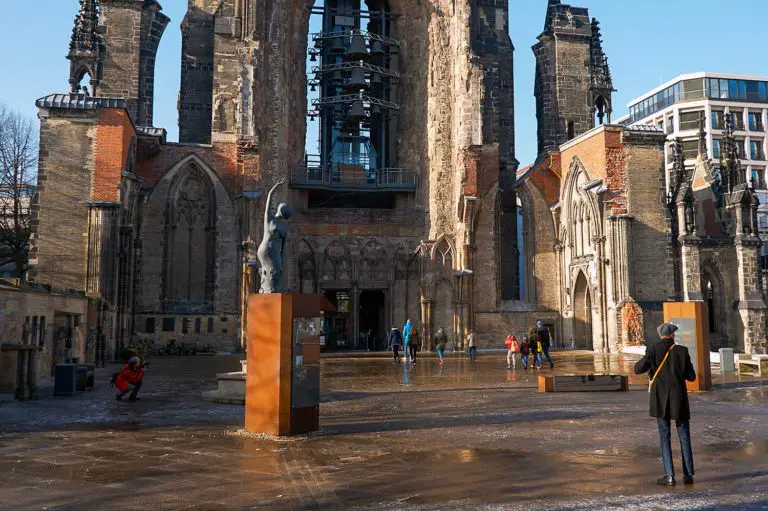
Today, St. Nicholas’ Church stands as a memorial to the victims of WWII. The memorial exhibits in the crypt provide many details of the events leading up to Operation Gomorrah, the air war over Europe. Beautiful sculptures sit inside, illustrating the futility of war and its disastrous consequences. A 51-bell carillon has been installed in the tower and sounds every Thursday at noon.
We visited the church on a walking tour of Hamburg and the experience still haunts me. The vast majority of people in Hamburg during Operation Gomorrah would have been perfectly ordinary citizens going about their daily lives – people just like me.
Contributed by Lesley of Freedom 56 Travel. Follow her on Twitter!
6. Comuna 13 – Medellin, Colombia
Medellin was once the most dangerous city in the world. When infamous drug lord Pablo Escobar controlled the city, crime was extremely high and the locals lived in fear. The neighbourhood of Comuna 13 had direct access to the main highway, making the exportation of drugs, weapons and other illegal goods extremely easy.
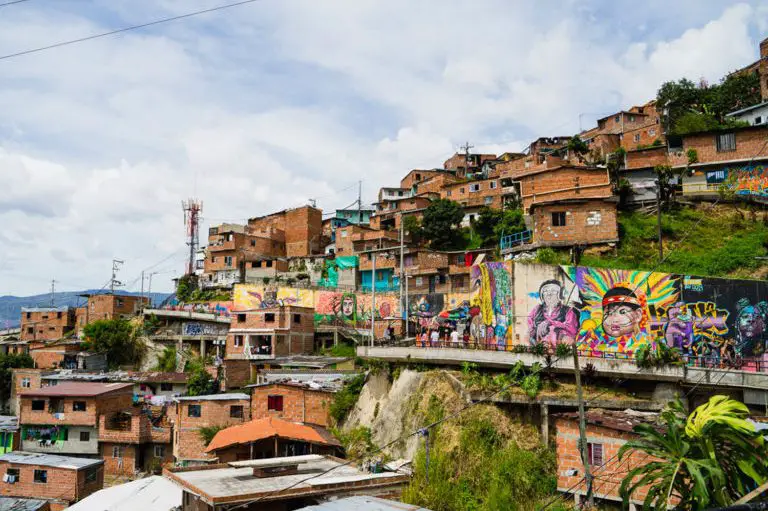
Drug cartels fought over control of the area and as a result, Comuna 13 was a very dangerous place. It was not uncommon to hear gunshots throughout the day and even to see dead bodies piled on the street. With that in mind, it might come as a surprise that Comuna 13 is now one of the most visited neighbourhoods in Medellin.
Over recent years, a tremendous amount of money has been invested in Comuna 13. A cable car system was installed to link it to the city centre. The resulting increase in tourism has sparked real change for the locals and the neighbourhood has become one of the country’s leading creative hubs.
Contributed by LivingOutLau. Follow him on Instagram!
7. Gulag Labour Camps – Karaganda, Kazakhstan
My trip to Kazakhstan left a deep impression on me. While I had heard about the so-called gulags, I did not know that most of them were in Kazakhstan. Stalin deported whole ethnic groups to the remotest corners of the country. This is how during WWII, the Volga Germans ended up in Karaganda.
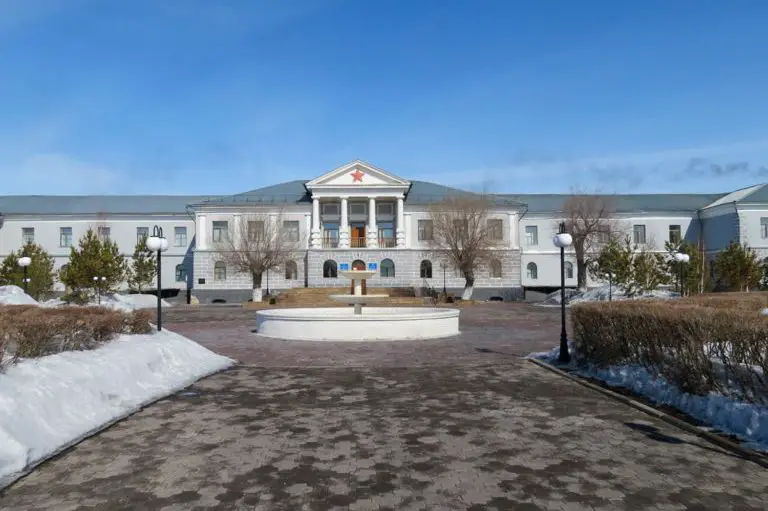
Stalin wanted to develop the farms and coal mines in Karaganda and set up a network of labour camps to support these projects. Political prisoners and deportees provided the free labour that was necessary.
Even though not much of the labour camps remain, Karaganda is the perfect example of a dark tourist site. There is an excellent Gulag Museum in the former headquarters of the labour camp in Dolinka.
Also nearby, the Ecological Museum covers other dark parts of Soviet history. The museum has an exhibition on the nuclear tests done in Kazakhstan and the debris that falls from the sky from the space program in Baikonur.
Contributed by Ellis of Backpack Adventures. Follow her on Instagram!
8. The Eruption of Mount Vesuvius – Pompeii, Italy
Pompeii was a thriving coastal city in Italy that was completely destroyed in 79AD when the neighbouring Mount Vesuvius erupted and covered the city in ash. It is a prime example of what is termed disaster tourism, where tourists visit a location where an environmental disaster has occurred.
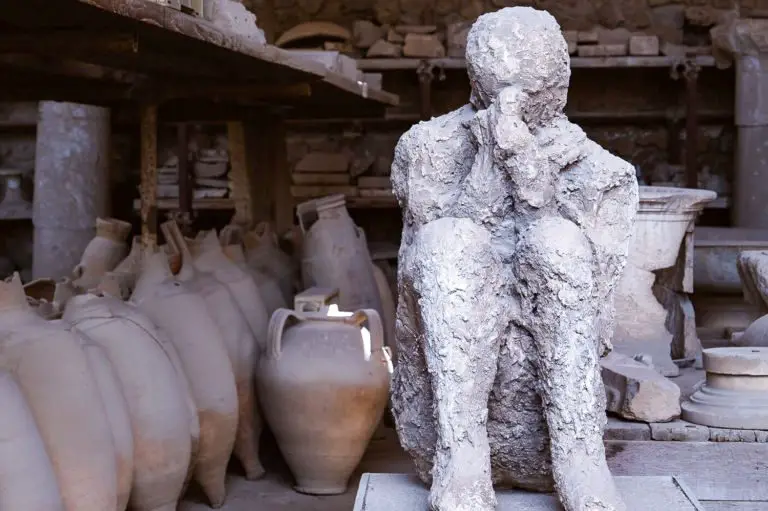
What makes the eruption of Mount Vesuvius more tragic was that the majority of people who died were slaves, who either had no means of escaping or were trapped. When archaeologists began excavating the site, they found several bodies. The ash preserved these bodies which allowed historians to create the human casts we see on site today.
Seeing these casts in crouching positions while covering their faces, gave me shivers. To get a greater understanding of the site and everything inside of it, I highly suggest finding a good tour guide. This photographic travel guide to Pompeii gives lots more tips for planning a visit.
Contributed by Natasha of And Then I Met Yoko. Follow Natasha on Instagram!
9. Mary King’s Close – Edinburgh, United Kingdom
Below the Royal Mile in Edinburgh hides an underground street paved with dark history. Mary King’s Close was alive with residents when the bubonic plague seized the country in 1645. The grievous epidemic turned the once-thriving close into a dreadful place, where its inhabitants suffered a slow and torturous death.
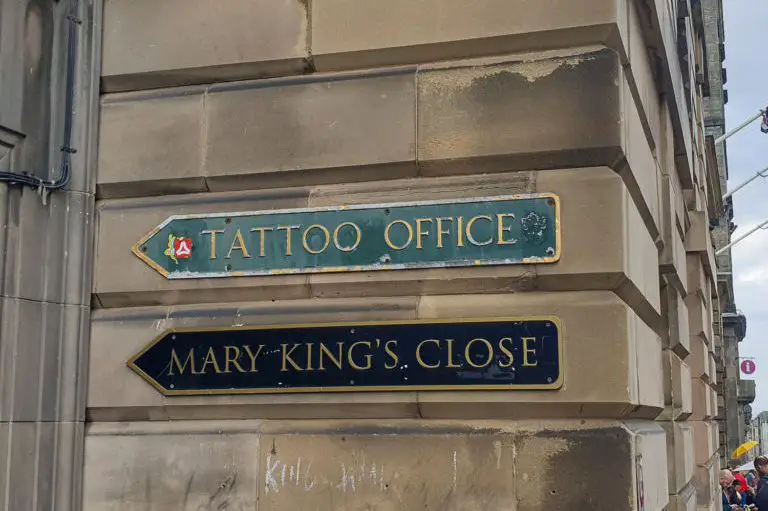
Mary King’s Close was sealed off and used as a foundation for the Royal Exchange in the late 1700s. Years passed and its terrible secrets were left trapped within its dark walls. In the 1990s, the close was rediscovered and opened to the public, allowing people to explore the subterranean streets that once festered with disease.
The mental image of the street once bustling with life left a lump in my throat – the locals had no idea how many would lose their lives to the Great Plague. Like Mary King’s Close, the entire city of Edinburgh is filled with dark and spooky places so be sure to check out Scotland’s capital if you’re a fan of the macabre.
Contributed by Wandering Crystal. Follow her on Instagram!
10. The Killing Fields and S-21 – Phnom Penh, Cambodia
During the Khmer Rouge genocide in Cambodia, execution, starvation and disease were allowed to flourish, killing an estimated three million people. Led by Pol Pot, the regime attempted to enforce brutal and inhumane policies to push Cambodia into being a classless society.
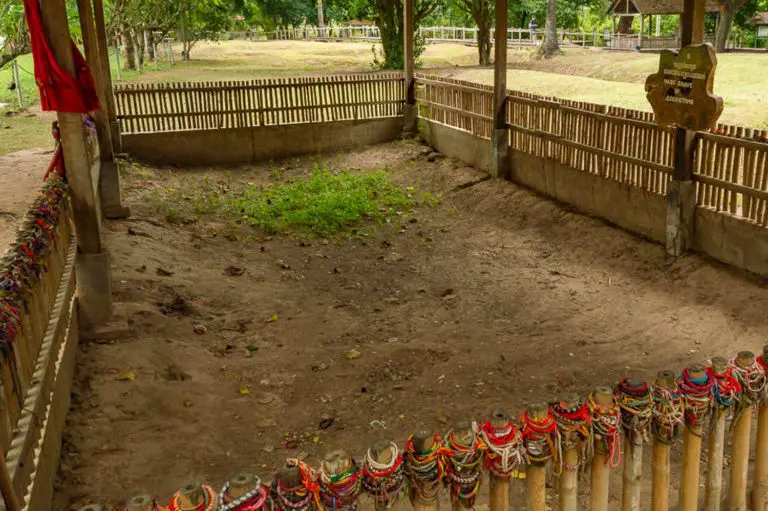
Phnom Penh and the surrounding area are home to S-21, a political prison used by the regime, and Choeung Ek, the largest of the Killing Fields. Over 12,000 prisoners were held at S-21 during the regime and with only seven known survivors, it’s a place known for unthinkable torture and suffering. The S-21 site now houses the Tuol Sleng Genocide Museum where you can learn more about the Cambodian massacre.
Much like S-21, a tour of the Cambodian Killing Fields can be hard to digest. There is a memorial stupa filled with the skulls of victims and you can still see bone fragments and strips of clothing along the paths. It’s a horrifying place but important to visit to ensure history doesn’t repeat itself.
Contributed by Ben at Horizon Unknown. Follow him on Facebook!
11. Abandoned Ghost Palace – Bali, Indonesia
Located near the village of Bedugul lies an abandoned hotel. Legend has it that in the early 1990s, the hotel began to be constructed by Tommy Suharto, the youngest son of the former Indonesian President. Tommy was later convicted of ordering the assassination of a judge who previously found him guilty of corruption and he subsequently went to prison. The hotel was never completed.
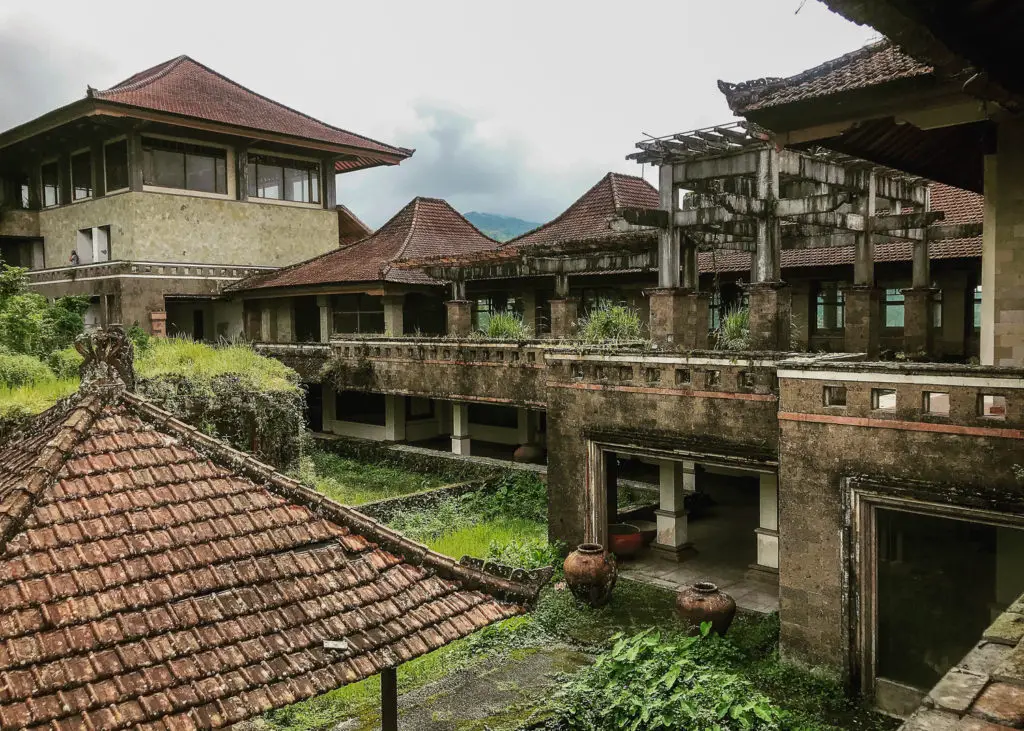
Another theory is that the hotel is haunted by the landlocked souls of labourers who were worked to death during its construction. The hotel, originally named Hotel Pondok Indah Bedugul, isn’t open for visitors but if you hand the guard 10,000 IDR, he’ll let you in to explore. I recommend seeing it as soon as possible because rumours indicate that visitors will no longer be permitted entrance (even with a bribe) because of how dangerous it is.
Contributed by Nat Wanderlust.
12. Auschwitz-Birkenau – Oświęcim, Poland
The “Final Solution to the Jewish Question” was the official code name for the murder of Jews during World War II. At least 1.3 million people were sent to Auschwitz by the Nazis and a shocking 1.1 million people were murdered by the SS, mainly in gas chambers.
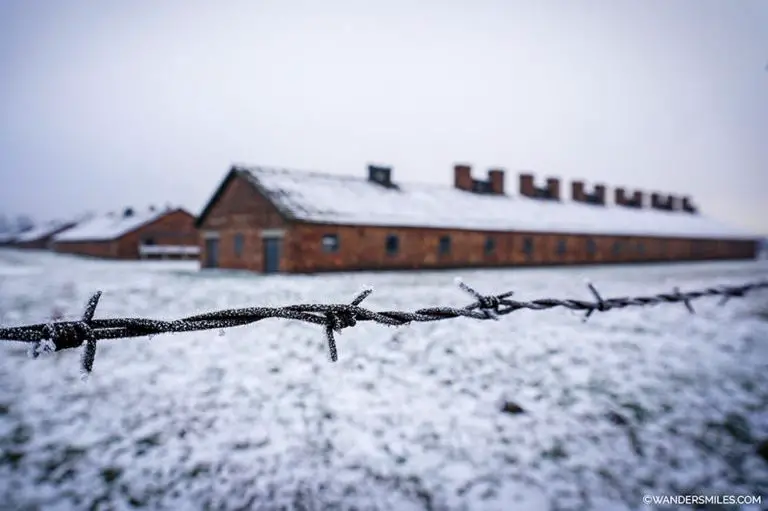
Auschwitz-Birkenau is located on two different sites. Auschwitz I comprises brick buildings and the Death Block where people were gassed. Auschwitz II, known as Birkenau, was opened as they could not cope with the scale of death at Auschwitz I.
On arrival, you’ll see the famous train tracks where people were transported in and either sent to the gas chambers or given labour duty. Once the latter were emaciated, they were gassed and replaced with new prisoners.
I cried in horror seeing the piles of shoes, suitcases and false legs that once belonged to people. Human hair was used to make felt for socks given to the forces in submarines – 293 sacks of hair were found on liberation. Words cannot describe the emotions you’ll have upon seeing this symbol of this horrific dark chapter in our history.
Contributed by Vanessa from Wanders Miles, follow her on Instagram!
13. Day of the Dead – Oaxaca, Mexico
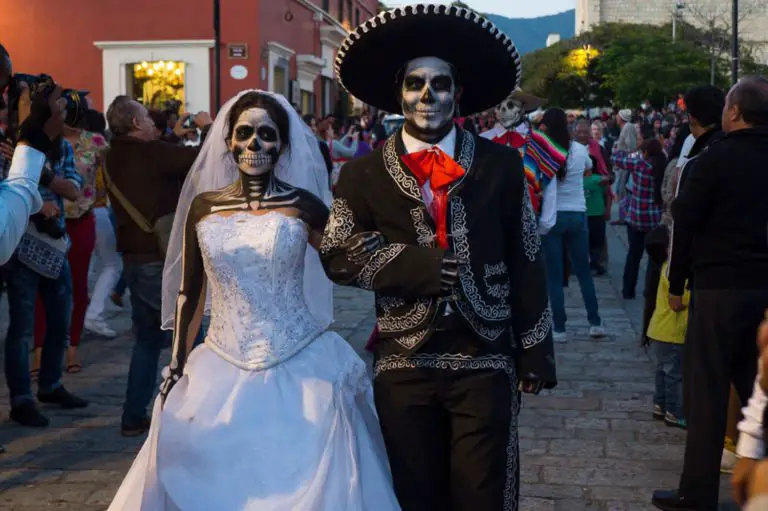
The Mexican Day of the Dead festival is a darkly uplifting event that occurs each year between October 31st and November 2nd. On these days, family and friends celebrate the lives of loved ones passed. It is widely believed that for three days each year, the veil between this world and the next is especially thin.
During the Day of the Dead festival, the spirits of the departed return to provide counsel to their living family members and friends. Much of the reunion is celebrated within the cemetery, where graves are cleaned and decorated for the occasion. On certain dates, families spend the whole night in the cemetery eating sugar skull sweets, drinking alcohol and playing music.
UNESCO recognises ‘Dia de Los Muertos’ as being ‘Intangible Cultural Heritage of Humanity’. Experiencing the Day of the Dead is a once-in-a-lifetime opportunity; especially in Oaxaca where visiting graves is commonplace. Prepare for everything you have ever thought about death to be challenged.
Contributed by Castaway With Crystal. Follow her on Instagram!
14. Red Terror Martyrs’ Museum – Addis Ababa, Ethiopia
The military junta who took power after Ethiopia’s Emperor Haile Selassie was ousted were known as the Derg. After prolonged internal wranglings, Mengistu, a soldier from the ranks, emerged as their leader and the dictator of Ethiopia.
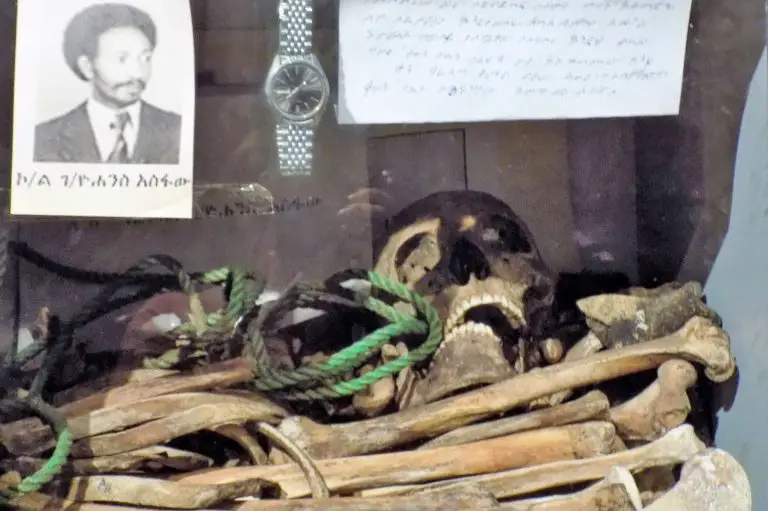
Within a couple of years, the Derg had created terror among ordinary Ethiopians, tens of thousands of whom had been imprisoned without trial and tortured, or worse, executed. The term ‘Red Terror’ comes from Mengistu’s famous speech when he smashed a bottle of blood to illustrate the killings to come. His regime is estimated to be responsible for the deaths of between 1.2 and 2 million Ethiopians.
Today, the horrors of Mengistu’s regime are remembered in the Red Terror Martyrs’ Museum in Addis Ababa. Opened in 2010, this small museum teaches about the atrocities of the regime. Photos of victims cover the walls alongside displays of human remains recovered from mass graves. We came away from the Martyrs’ Museum appalled by man’s inhumanity to man.
Contributed by Andrea of Happy Days Travel Blog. Follow her on Facebook!
15. Constitution Hill – Johannesburg, South Africa
Constitution Hill is now a living museum which tells the story of South Africa’s journey to democracy. It’s hard to comprehend that people like Nelson Mandela and Mahatma Gandhi served time here in the 1960s and that the prison was still operational until 1982.
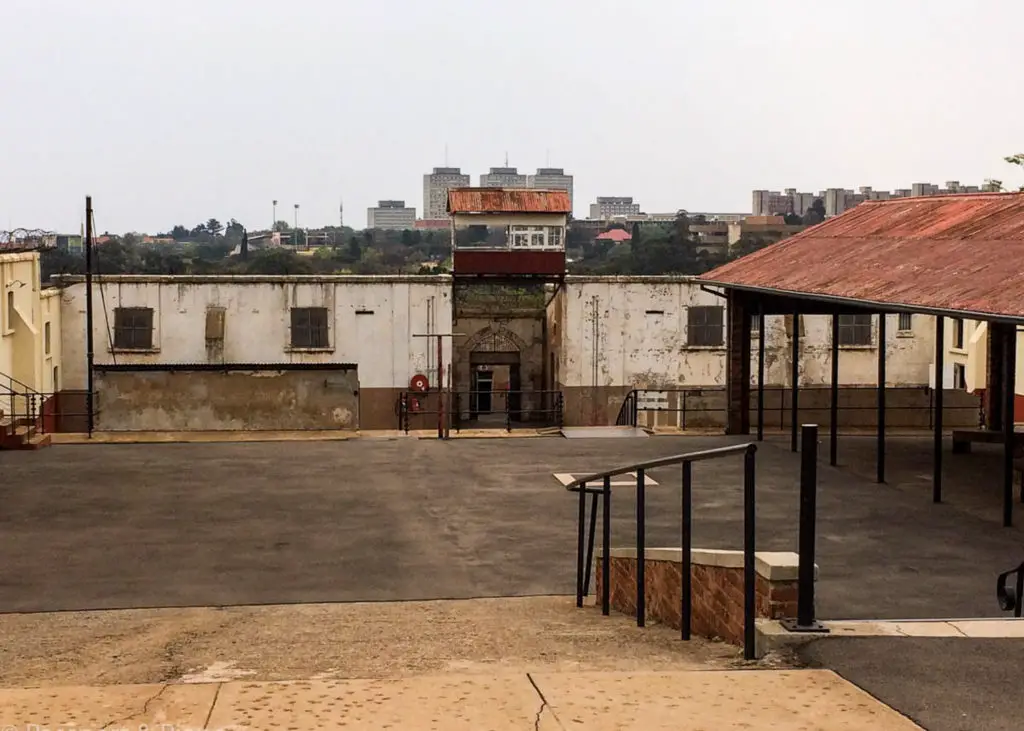
There are several sites that you can visit at Constitution Hill. The Old Fort is where white male prisoners were housed. Although the cells were overcrowded and unhygienic, the rooms are larger than those of the black prisoners. They were held in Block number 4. There was very little daylight and as I stepped inside, I was terrified that someone would shut the cell door behind me.
There’s also the Awaiting Trial Block. The block was demolished and the bricks were used to build South Africa’s new Constitutional Court. Thankfully this court serves to uphold the rights of all South Africans, regardless of colour, but the bricks are a poignant reminder of its troubled past.
Contributed by Fiona of Passport and Piano. Follow her on Facebook!
16. Shanghai Tunnels – Portland, USA
In a city known for the slogan ‘Keep Portland Weird,’ the Shanghai Tunnels fit right in. It’s believed that from 1850 until 1941, men in Portland, Oregon, were regularly kidnapped and sold to ship captains as labourers. During this period, there was a shortage of labour available for the city’s booming shipping industry and this created a black market.
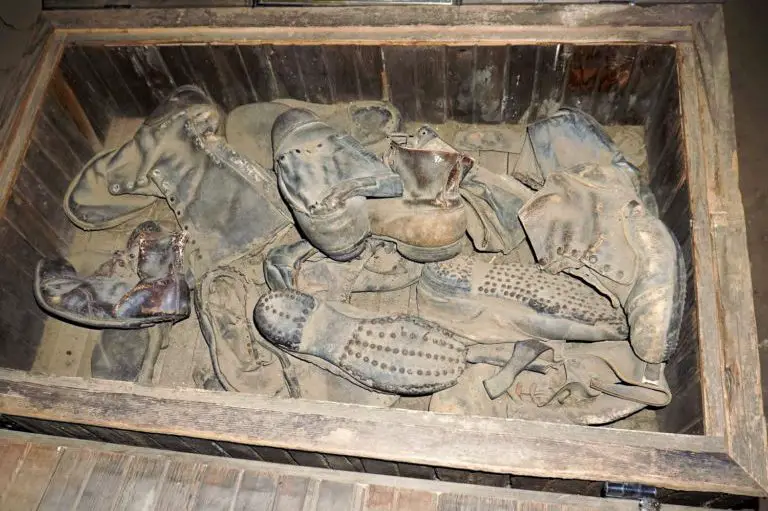
To capture these men, underground tunnels originally built to move inventory between businesses were repurposed for illicit use. Trapdoors were even installed in some of the local bars so that drunk men would drop into the tunnel below.
Today, tours of these tunnels are offered daily by a non-profit organisation, Shanghai Tunnels/Portland Underground. All tour participants are advised to be prepared for spending an hour in a confined space. While the nature of the tour is sad and tragic, it’s an important part of Portland’s history.
Contributed by Wendy of Empty Nesters Hit the Road. Follow her on Facebook!
17. Brno Ossuary – Brno, Czech Republic
Of the attractions in Brno, several of them could be classed as dark tourism attractions. The one that moved me the most, though, was the ossuary underneath the St. James Church.
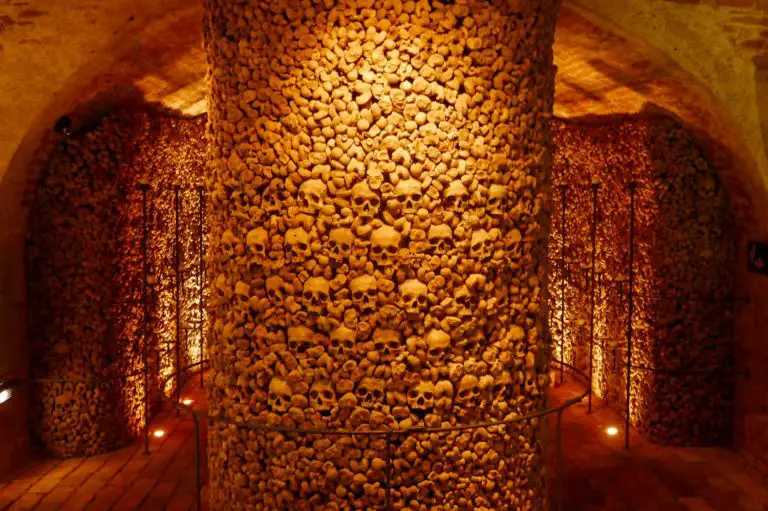
Surrounding this church, which is known as the ‘Kostnice u sv. Jakuba’ in Czech, was one of the main churchyard cemeteries in Brno. Eventually, as the city grew, there was no room left for new burials so a grave rotation system was adopted.
When a burial took place, the body was left in the grave for between 10 to 12 years. After that, the bones were taken out to make room for the next burial. The displaced remains were then relocated to the ossuary, where bones from thousands of graves were piled up.
It’s estimated that Brno Ossuary holds the bones of more than 50,000 people, which makes it the second-largest ossuary in Europe; only second to the Paris catacombs. The mortal remains laid to rest here include victims of the Swedish siege of Brno and the Thirty Years’ War, as well as many victims of plague and cholera epidemics.
Contributed by Wendy of The Nomadic Vegan. Follow her on Instagram!
Do you have any dark tourism examples to share? Let us know in the comments!

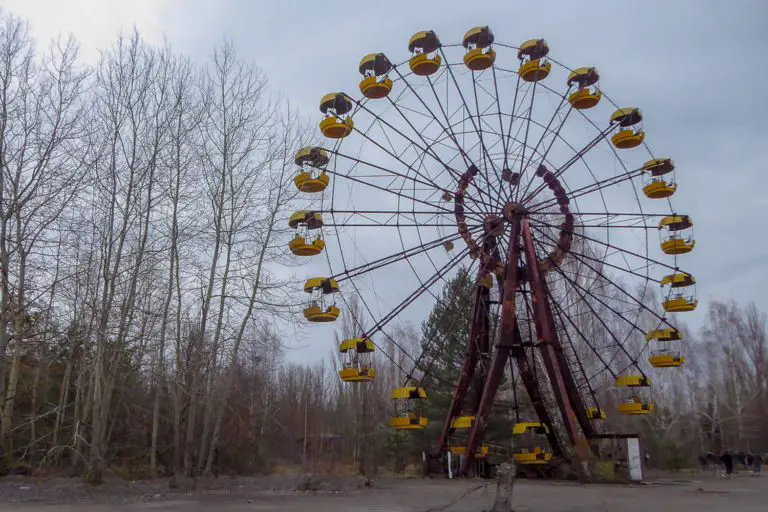
Comuna 13 is spellt with only 1 -m-.
I wonder why choose the cemetery in Sucre, when so many others are more characteristic (eg. Père Lachaise in Paris) or even ‘livelier’ (eg. in Santiago de Chile).
Interesting & important topic though. I’m in the process of rewriting an article about the mines of Potosi. That is one dark tourism destination I strongly oppose, for one simple reason; people are still dying in there.
Thanks for the heads up Anthony! 🙂
I chose the cemetery in Sucre because it was a little bit off the beaten track – I like visiting the lesser known places as well as the more famous ones.
I can understand your point about the mines of Potosí and can see why you disagree with it. I must say though, from my own personal experience, I found my visit to be hugely enlightening. I was initially very torn about the idea of visiting an active mine but in the end, we chose a company run by an ex-miner who took us into the mine personally. In my opinion, our visit never felt voyeuristic at all and the miners seemed very grateful for the tourists visiting. A percentage of the tour cost went directly into the funding the healthcare of the miners when needed and also towards maintenance of the mine.
Such a great and informative post, Sheree! There were so many sites here that I was not even aware of – that is why sharing posts about dark tourist sites is so important! It really helps educate the world and helps us honour the past and the lives that were lost at some of these sites.
Like you, I am a huge fan of cemeteries. It is so wonderful that some countries treat death as a natural normal part of life (unlike some of our countries!). It really helps people remember happy memories of their loved ones they recently lost.
Thanks so much for being a part of it Crystal! I also learnt about loads of new dark tourism sites – it has definitely been an eduction as there was plenty of these I had never even heard of. It is definitely important to make sure the stories behind these places get told.
Thank you for including us in this fantastic collab!
I love how varied these sites are, and that you’ve included a lot of lesser know dark tourism destinations mixed in with some of the big ones. Even as professional dark tourists (that’s a thing, right?), we hadn’t heard of all of these places. The Shanghai Tunnels were completely new to me, but definitely want to head to Portland now.
I’m also a little embarrassed to admit that despite being to Hamburg MANY times, I was not aware of the St. Nicholas’ Church. I blame that on the fact that I was visiting a friend and not really touristing…
Awesome post everyone! I think it is really important for people to visit at least one of these in their lifetime. I think we are jaded from the major events that happened to our world and it’s people when we are told the stories. To see the places in real life, it puts life into perspective and how crazy life can be if we don’t fight for what is right.
I couldn’t agree more. Even though visiting these kinds of places is hard, I still think it is really important to help us realise the human effect of what we see on the television. As you said, it is only once you truly understand the devastation that you realise the importance of fighting for the right things.
Great article . I’ve been to a lot of places around the world and haven’t even heard of some of these .
Thanks Jennifer! I’ve certainly added a lot of places to my future visit list!